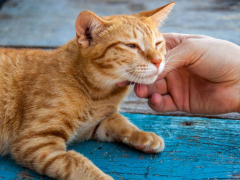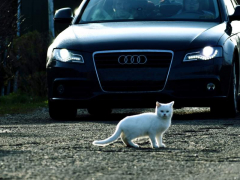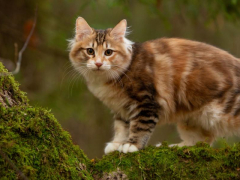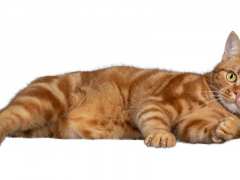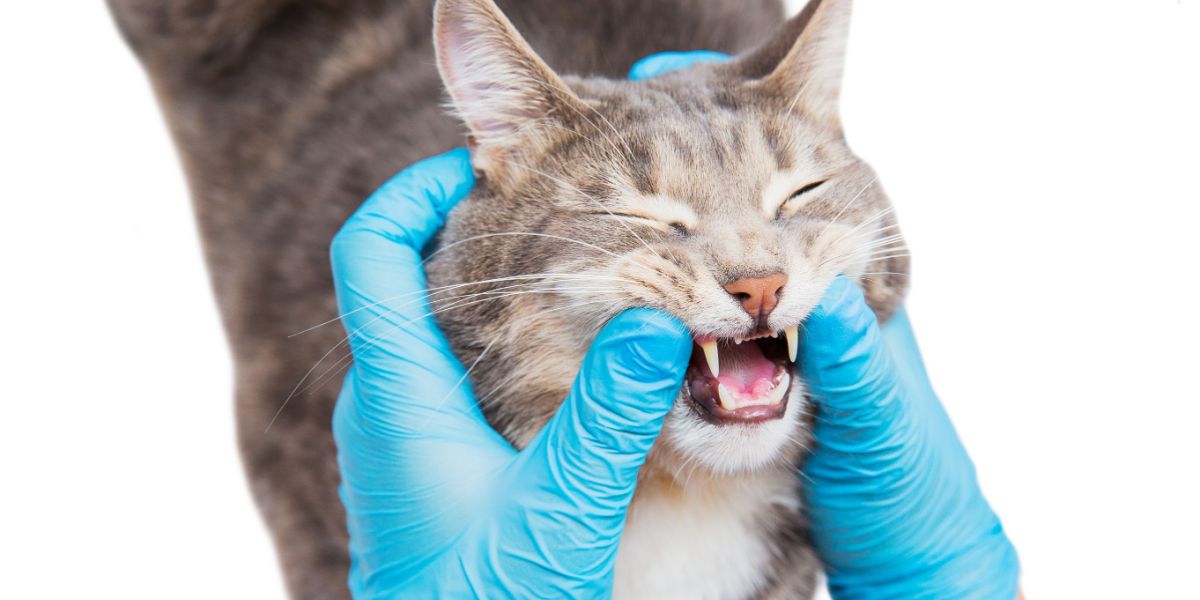
Seeing a cat bleeding from their mouth can be very scary for pet owners. There can be several potential causes: some more minor, such as infections or dental disease, and some more concerning, such as cancer. In this article, we’ll review the most common ones, how to recognize them, how they’re treated, and some frequently asked questions.
Cat Bleeding From Mouth: What to Look For
If a cat is bleeding from the mouth, there are a few ways this may present. Following is a list of some appearances you may see.
- Blood on the fur around the mouth
- Saliva/drool around the mouth with a pink or red tinge
- Drops of blood on the floor or where your cat sleeps
- Blood or stains on toys
- Blood or staining on food, food bowls, or water bowls
Possible Causes of Cat Bleeding From Mouth
Gingivitis/Stomatitis
Gingivitis is inflammation of the gums. Stomatitis is the term that applies when inflammation is present in other parts of the oral cavity like the inside of the cheeks, roof of the mouth, soft palate, and early part of the throat. A cat that has severe inflammation of both the gums and the rest of the mouth can be referred to as having gingivostomatitis.
The inflammation that leads to gingivostomatitis may be so severe in some cases that the irritated or ulcerated tissue may bleed. This may especially occur when a cat is eating something harder like kibble, or chewing on a toy.
There are many underlying causes for gingivostomatitis. Major ones can include periodontal/dental disease, viral infections (especially feline leukemia virus, feline immunodeficiency virus, feline herpesvirus and feline calicivirus), immune disorders, bacterial and fungal infections, and trauma.
Gingivostomatitis can be associated with feline oral resorptive lesions (FORLs), which are ulcerations that develop on the teeth and advance until the entire tooth dissolves itself. These lesions are painful and can bleed as well.
It may be hard to tell if your cat has gingivitis or stomatitis if they won’t allow you to take a good look in the mouth. Symptoms can include shaking the head, pawing at the mouth, difficulty eating or dropping food while trying to eat, swatting at the food bowl, and behavioral changes like lethargy and irritability. Chattering teeth is a sign of oral pain where a painful stimulus in the mouth such as to a sore or wound, will immediately lead to a visible quivering, or chattering of the mouth and teeth.
Wounds and Trauma
Any kind of wound that causes an abrasion or cut in the mouth can contribute to bleeding. Trauma to the face or mouth may lead to chipped or damaged teeth. Blunt trauma may also allow a kitty’s sharp teeth to puncture or cut the inner surface of the cheek or cause a cat to bite their tongue, causing bleeding.
Trauma can also include burn injuries. Cats prone to chewing on electrical cords can get a bad electrical burn in their mouth if they manage to chew through the insulation.
Outdoor cats are at higher risk for trauma, especially from falls and bite wounds from other animals. But never forget about potential indoor hazards like electrical cords, falls from high places, or sharp objects left around the house that may cause harm.
Foreign Objects
Similar to trauma, a foreign object lodged in the mouth can also contribute to bleeding. This can include objects like sewing needles or pins for our kitties that can’t resist the sewing or crafts room. Other objects can include other pieces of metal like screws, sharp pieces of plastic, and cracked glass or ceramic.
In many cases, a cat with a piece of foreign material like this lodged in their mouth will act very abnormally. They may make abnormal or exaggerated chewing motions, paw at the mouth, shake their head, or act irritable. Some cats may act aggressively towards their food while being reluctant to eat it.
Chronic foreign bodies can also cause mouth bleeding as well, secondary to the inflammation of them being there for a while. Examples could include bits of fabric or cloth or a piece of rubber or plastic that get lodged between teeth.
Infection
An infection in and around the mouth can lead to bleeding from the infected site. The face is a common location for bite wounds to occur on cats that get into fights with other cats.
It’s not uncommon for a bite wound to develop into an abscess. When bacteria multiply and inflammatory cells the body uses to fight the infection do as well, fluid called pus builds up within that space. This fluid can accumulate and cause visible swelling. Eventually, an abscess, following the path of least resistance, will open and the fluid inside will leak out, which may have a bad odor. While we often think of pus as white, it many cases it contains a fair amount of blood too and may resemble something actively bleeding.
Also Read: Bacterial Infections In Cats: Causes, Symptoms, & Treatment
Tumor
Unfortunately, cancerous tumors can always be a potential concern, especially for older cats. Squamous cell carcinoma (SCC) is by far the most common malignant cancer that occurs in a cat’s mouth.
In cats, SCC most often occurs under the tongue or along the gums. It may appear as a small mass, especially beneath the tongue. If it occurs along the gums, the most obvious sign may be that one or more teeth in that area are severely affected by inflamed and irritated gums. Teeth may sometimes fall out.
Tissue affected by SCC often develops ulceration and bleeds easily, even when the affected area is small. Unfortunately, it often occurs in parts of the mouth that are difficult to see easily. The most obvious outward signs can include reluctance to eat, pawing at the mouth, and excessive drooling/salivating. Saliva may sometimes have a blood tinge to it.
A fibrosarcoma is the next most common malignant tumor in cats. It is very locally aggressive and invasive. While it may not ulcerate or bleed easily like SCC, it may grow to a size that causes the teeth to poke into it, leading to bleeding.
There is a benign tumor called an epulis or fibroma, which occurs on the gums adjacent to teeth. These do not bleed on their own, but may if a tooth comes into contact with one while a cat is chewing.
When to Call the Vet
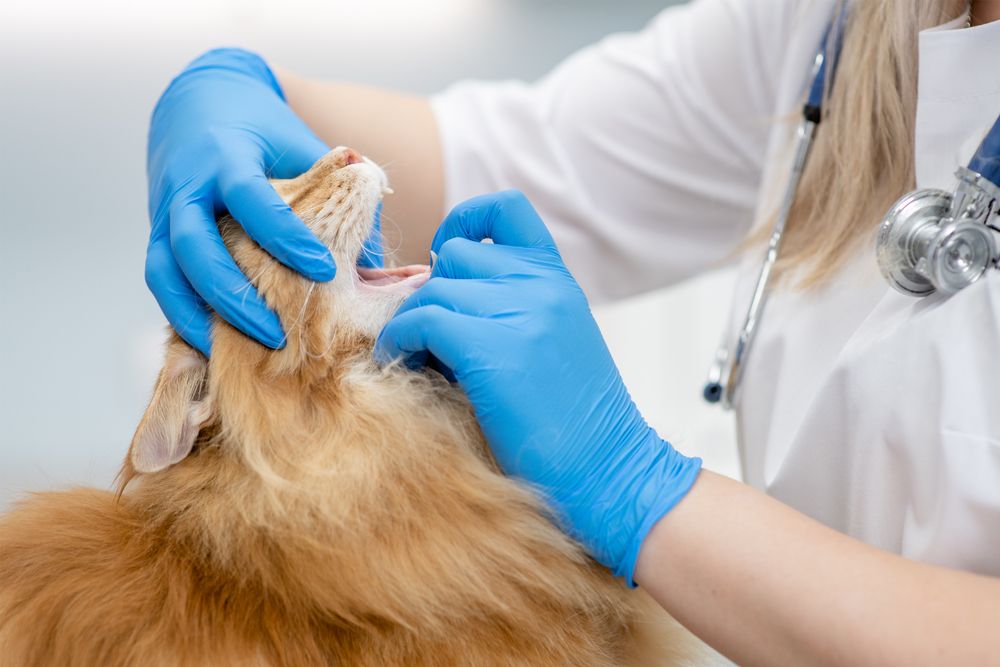
If there is a history of blood from the mouth, a veterinarian will perform a full physical examination of your cat.
Any time blood is seen coming from the mouth, it’s important to get a same day visit with your vet, even if your cat appears to be acting okay otherwise. Cats are very good at hiding or masking signs of pain and may be in more discomfort than they’re letting on.
If you see blood in or around your cat’s mouth and this is coupled with other abnormal signs like lethargy, hiding, lack of appetite or visible signs of pain, this should be considered an emergency with need for immediate care. This is also the case for any confirmed or suspected trauma where bleeding from the mouth occurs after.
Treating Bleeding From the Mouth
For all of the potential causes we reviewed, we’ll now discuss how your vet may arrive at a diagnosis and what treatment options may be discussed.
Gingivitis/Stomatitis
More simple gingivitis is often seen and discussed during annual or biannual physical exams. An anesthetic dental cleaning procedure will usually be recommended.
Severe gingivitis, stomatitis, or gingivostomatitis can be more complicated. Testing for feline leukemia virus and feline immunodeficiency virus may be recommended to rule these out as causes. More full labwork testing and dental x-rays may also be advised.
Initial improvement may be seen with medical treatment using antibiotics and steroid medication, but while improvement may be seen, a cure is not common. In some cats where the inflammation is so severe that it causes them constant pain, removal of all teeth with a full mouth tooth extraction under general anesthesia is often needed to bring relief. Because cats are able to swallow parts of their food whole, most cats can adjust to having no teeth. Cat owners often are surprised to find that their cats actually eat much better when the source of pain is removed.
Also Read: What to Do if Your Cat Is Sneezing Blood
Wounds and Trauma
How a wound is approached and treated will depend on the type of wound it is and how serious. The source of some wounds may not be visible during a basic veterinary exam, or a painful cat may not allow a vet to safely look at the area. In these cases, your vet may discuss the need for some sedation that will allow them to view a painful area in the mouth without causing your cat pain and stress.
Some types of trauma to the head or mouth may necessitate an x-ray to assess the presence of any other injuries like bone fractures.
Some wounds may be stitched/sutured closed while others, especially involving teeth, may require an anesthetic dental procedure to address.
Antibiotics and pain medication are common for all wounds of the mouth.
Foreign Object
A foreign object may be apparent during a physical exam, or a sedated exam may be needed for your vet to get a proper look. Sometimes, an x-ray may be needed, especially if an object like a pin or needle may be suspected.
Many foreign objects may be removed under sedation, but sometimes removal may be complicated enough to require anesthesia, especially if an object is lodged between teeth or is further back near the throat.
Infection
Some infections may be treated in a straightforward way with antibiotics and pain medication.
Abscesses may require additional care with sedation or anesthesia to flush the abscess out and clean it of debris first. Large abscesses may also need placement of a drain temporarily to aid in healing of the wound area.
Tumor
Treatment of an epulis/fibroma is typically achieved by removing it under anesthesia. This is often performed during an anesthetic dental procedure. Sometimes, a tooth associated with it must also be removed to ensure the epulis does not grow back. Once these are completely removed, they are considered cured.
This is unfortunately not the case for the malignant tumors we discussed: squamous cell carcinoma and fibrosarcoma.
How treatable these tumors are depends often on their size and location. SCC often occurs under or near the tongue, making them impractical to remove surgically. Cancers occurring in the gum may be removed surgically but may require an invasive procedure where a part of the jaw bone must also be removed, if the tumor has spread into the bone.
Tumors that cannot be removed surgically may have other medical treatments, but these are usually palliative and focused on addressing pain and helping quality of life as much as possible. Euthanasia may unfortunately be recommended in many cases, especially if a cat is painful and unable to eat.
Also Read: 10 Subtle Signs Your Cat May Be Sick
Prevention of Bleeding From the Mouth in Cats
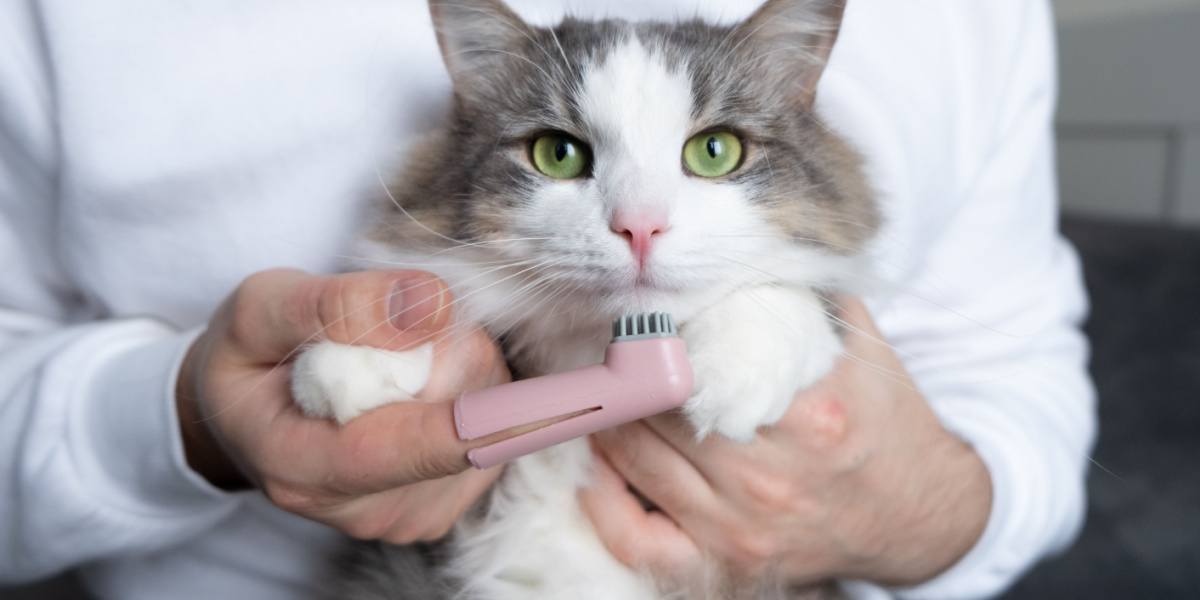
Regular toothbrushing is recommended for all cats, to ensure good oral hygiene
Similar to treatment options, we’ll have a look at some ways to approach prevention of causes that lead to bleeding from the mouth in cats.
Gingivitis/Stomatitis
Prevention of gingivitis secondary to dental disease can be achieved with good dental care at home coupled with dental cleaning procedures with your vet. Just like people, the best dental care at home for cats starts with regular brushing. If your cat is not amenable to brushing, dental treats and oral hygiene water additives are reasonable follow-up strategies.
Some cases of more advanced gingivostomatitis occur chronically in cats that have not had their dental disease addressed.
But the many other causes of gingivostomatitis may not be easily preventable. FeLV and FIV viruses may be prevented by keeping your cat indoors and limiting exposure to outdoor cats. The FeLV and FVRCP vaccines can help prevent some viruses that can cause gingivostomatitis.
Some cats may be genetically predisposed to more advanced dental disease and oral inflammatory changes. The underlying causes for immune-related disorders may not always be apparent or preventable.
Wounds/Trauma
Accidents happen, but there are ways to do our best to prevent them. Outdoor cats will always carry the greatest risk for traumatic injuries. Keeping your cat indoors can greatly lower risk for vehicular trauma, bite wound injuries, and serious injuries from falls.
But indoor cats can have their share of injuries too. Make sure access to risky areas like workrooms, the garage, sewing/craft rooms, and utility closets that contain sharp objects are kept off limits.
Electrical cords should be kept hidden as much as possible. Use zip ties to keep groups of cords contained, organized, and less of an enticement.
Foreign Object
Prevention of foreign object ingestion can be tricky, as cats will seek out what they want and are very good at it. But proofing your house against things like pins, needles, nails, screws, or anything else your kitty may like to chew on is the best approach. Whole rooms or closets containing these types of items should be made inaccessible. Never encourage your cat to play with unsuitable items, and always redirect inappropriate play towards a cat-safe toy.
Infection
Infection can be prevented by maintaining good dental health and reducing risk for trauma and wounds that may lead to an infection.
Abscesses are most often caused by fights with other cats. Risks are always higher for outdoor cats, but it’s important to closely monitor multi-cat households and ensure that individual cats have areas to be alone or take refuge from housemates.
Tumor
Sadly, there is no known way to prevent oral tumors in cats. While squamous cell carcinoma in cats has been linked to sun/UV exposure, this is only for cancer lesions occurring on the skin and not for those inside the mouth.
The best approach for oral tumors is detecting their presence as soon as possible so that early interventions can be made.
-
Beckman, B. Recurrent Oral Hemorrhage in a Cat - an unusual etiology. DVM 360. Published April 1, 2010. Accessed June 14, 2023. https://www.dvm360.com/view/recurrent-oral-hemorrhage-cat-unusual-etiology
-
Cornell Feline Health Center. Feline Dental Disease. Cornell University College of Veterinary Medicine. Updated June 2017. Accessed June 14, 2023. https://www.vet.cornell.edu/departments-centers-and-institutes/cornell-feline-health-center/health-information/feline-health-topics/feline-dental-disease
-
Downto78. Cat Bleeding from Mouth: Causes and Treatment. Downtown Athens Vet. Posted March 11, 2022. Accessed 6/14/2023. http://downtownathensvet.com/cat-bleeding-from-mouth/
-
Eddlestone, S. Stomatitis in dogs and cats (Proceedings). DVM 360. Published August 1, 2008. Accessed June 14, 2023. https://www.dvm360.com/view/stomatitis-dogs-and-cats-proceedings
-
Reiter, A.M. Disorders of the Mouth in Cats. Merck Veterinary Manual Online. Last Modified, October 2022. Accessed June 15, 2023. https://www.merckvetmanual.com/cat-owners/digestive-disorders-of-cats/disorders-of-the-mouth-in-cats
